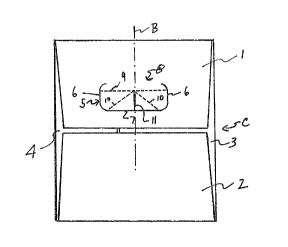Some of the information on this Web page has been provided by external sources. The Government of Canada is not responsible for the accuracy, reliability or currency of the information supplied by external sources. Users wishing to rely upon this information should consult directly with the source of the information. Content provided by external sources is not subject to official languages, privacy and accessibility requirements.
Any discrepancies in the text and image of the Claims and Abstract are due to differing posting times. Text of the Claims and Abstract are posted:
| (12) Patent: | (11) CA 2092023 |
|---|---|
| (54) English Title: | END LOAD CARTON HANDLE IMPROVEMENT |
| (54) French Title: | PERFECTIONNEMENT DES FENTES DE PREHENSION DES PAROIS D'EXTREMITE DE CARTONS PORTE-BOUTEILLES |
| Status: | Deemed expired |
| (51) International Patent Classification (IPC): |
|
|---|---|
| (72) Inventors : |
|
| (73) Owners : |
|
| (71) Applicants : | |
| (74) Agent: | MOFFAT & CO. |
| (74) Associate agent: | |
| (45) Issued: | 1997-11-18 |
| (22) Filed Date: | 1993-03-19 |
| (41) Open to Public Inspection: | 1994-09-20 |
| Examination requested: | 1993-03-19 |
| Availability of licence: | N/A |
| (25) Language of filing: | English |
| Patent Cooperation Treaty (PCT): | No |
|---|
| (30) Application Priority Data: | None |
|---|
A bottle carrying carton for carrying bottles in an upright
state includes a bottom panel on which said bottles are arranged.
Opposed side panels and opposed end panels are provided, each end
panel having a handle flap cut therein to define a handle upon
being folded inwardly. The invention relates to an improvement
comprising a primary fold line formed in the handle flap from one
side to the other thereof, and a slit formed in the handle flap
from the mid point of the primary fold line to the lowermost edge
of the handle flap.
La présente invention vise un panier en carton servant à transporter des bouteilles en position verticale. Le panier est constitué d'un panneau de fond sur lequel sont disposées les bouteilles, deux panneaux latéraux et deux panneaux d'extrémité dans lesquels des poignées sont découpées et qui permettent de transporter le panier lorsqu'elles sont pliées vers l'intérieur. L'invention vise plus particulièrement l'amélioration de ces poignées découpées constituées d'une ligne de pliage principale se prolongeant d'un côté à l'autre, et d'une fente se prolongeant, elle, du point médian de la ligne de pliage jusqu'au bord le plus bas de la poignée.
Note: Claims are shown in the official language in which they were submitted.
Note: Descriptions are shown in the official language in which they were submitted.

For a clearer understanding of the status of the application/patent presented on this page, the site Disclaimer , as well as the definitions for Patent , Administrative Status , Maintenance Fee and Payment History should be consulted.
| Title | Date |
|---|---|
| Forecasted Issue Date | 1997-11-18 |
| (22) Filed | 1993-03-19 |
| Examination Requested | 1993-03-19 |
| (41) Open to Public Inspection | 1994-09-20 |
| (45) Issued | 1997-11-18 |
| Deemed Expired | 2006-03-20 |
There is no abandonment history.
| Fee Type | Anniversary Year | Due Date | Amount Paid | Paid Date |
|---|---|---|---|---|
| Application Fee | $0.00 | 1993-03-19 | ||
| Registration of a document - section 124 | $0.00 | 1993-09-17 | ||
| Maintenance Fee - Application - New Act | 2 | 1995-03-20 | $100.00 | 1995-02-20 |
| Maintenance Fee - Application - New Act | 3 | 1996-03-19 | $100.00 | 1996-02-19 |
| Maintenance Fee - Application - New Act | 4 | 1997-03-19 | $100.00 | 1997-03-04 |
| Final Fee | $300.00 | 1997-06-27 | ||
| Maintenance Fee - Patent - New Act | 5 | 1998-03-19 | $150.00 | 1998-02-17 |
| Maintenance Fee - Patent - New Act | 6 | 1999-03-19 | $150.00 | 1999-02-24 |
| Registration of a document - section 124 | $50.00 | 1999-09-07 | ||
| Maintenance Fee - Patent - New Act | 7 | 2000-03-20 | $150.00 | 2000-02-18 |
| Maintenance Fee - Patent - New Act | 8 | 2001-03-19 | $150.00 | 2001-02-21 |
| Maintenance Fee - Patent - New Act | 9 | 2002-03-19 | $150.00 | 2002-02-19 |
| Maintenance Fee - Patent - New Act | 10 | 2003-03-19 | $200.00 | 2002-11-21 |
| Maintenance Fee - Patent - New Act | 11 | 2004-03-19 | $250.00 | 2004-02-19 |
Note: Records showing the ownership history in alphabetical order.
| Current Owners on Record |
|---|
| MOLSON CANADA |
| Past Owners on Record |
|---|
| MACLEAN, CHRIS |
| MOLSON BREWERIES |